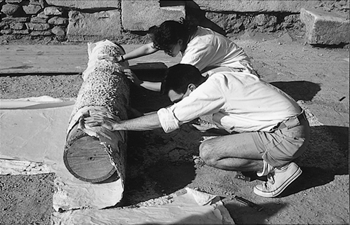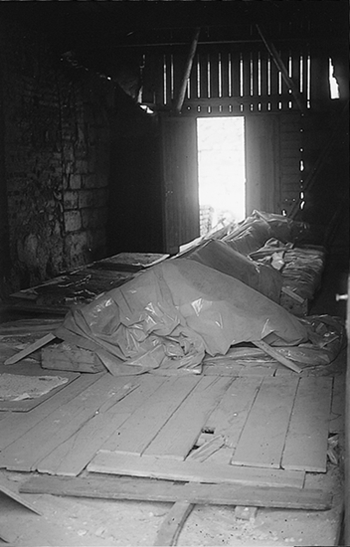RECOVERY OF UNBACKED MOSAICS FROM A STORAGE DEPOT FIRE AT THE SARDIS EXCAVATIONS, TURKEYKENT SEVERSON, STEPHEN KOOB, JULIE WOLFE, PERRY CHOE, STEPHANIE HORNBECK, SARAH MCGREGOR HOWARTH, & ANTHONY SIGEL
1 1. INTRODUCTIONThe principle that ancient mosaics are an integral part of the buildings in which they are originally installed and that every effort should be made to preserve them within that context has long been widely accepted (Second International Congress 1964, Article 8), and increasingly in situ treatment is chosen as the most appropriate method for conservation of excavated mosaics (Getty Conservation Institute 1991; Nardi 1996). Nonetheless, there are times when it becomes necessary to remove mosaics from the buildings in which they were made (Mora 1980). Such circumstances may include a threat of vandalism or theft from an unprotected site, danger from natural phenomena, or the need to lift the mosaic in order to explore strata underneath. Sardis, an archaeological site in western Anatolia, has been occupied by numerous civilizations since antiquity. Sardis is unique in the region for having been the capital of the Lydians, whose period of greatest strength extended from the 9th to the mid-6th century b.c. To explore the Lydian material, it is often necessary to go through deposits left by later occupants. In 1989, under the auspices of the Harvard-Cornell Archaeological Exploration of Sardis (Crawford H. Greenewalt Jr., field director), a series of early 5th- and early 6th-century a.d. Roman floor mosaics was discovered in the sector known as MMS/N, between an ancient east-west road and the modern Izmir-Ankara highway (Greenewalt et al. 1993). These mosaics were typical Roman paving mosaics made up of relatively large stone tesserae, approximately 1–2 cm sq., set in lime mortar. In subsequent seasons, more mosaics were unearthed in the same sector as the excavation continued to the east (Greenewalt et al. 1995). The mosaics (fig. 1) had been built above a critical juncture in the Lydian defense wall, and it was deemed necessary to remove these later features to investigate the Lydian structures below. When exploration of the Lydian levels was complete, the mosaics would be reinstalled in their original location as part of an overall plan for presentation of the MMS/N sector to the public.
Beginning in 1990, portions of the mosaics were lifted by application of animal glue, cotton cloth, and paper facing (fig. 2). The mosaics were divided into sections, loosened from the bedding mortar by pounding, and lifted directly or by rolling (Salzman and Sherman 1990; Griffen and Salzman 1991; Griffen and Tokumaru 1992) (fig. 3). The traditional glue-facing method was chosen for its low cost and the ease with which needed materials could be obtained. In addition, removal of the facing after backing would require only warm water rather than organic solvents, which are expensive and difficult to use in the hot Turkish summer climate. The drawbacks of glue-based facings are, of course, their susceptibility to water damage and the eventual deterioration over time. These issues were of serious concern at the time of lifting; however, it was hoped that sufficient resources would be devoted to backing and stabilizing the mosaics so that the project would be completed in two or three years.
The first mosaics were lifted in 1990 from a level slightly above most of the remaining mosaics. These were generally fragmentary, and every effort was made to utilize the losses and broken edges in dividing up the largest sections. The largest section of the mosaic was lifted in 1991. The floor was cut during lifting into regular sections along lines in the design of the mosaic to facilitate handling, yielding roughly rectangular sections 1–2 m sq. Several additional small sections were lifted in the 1992 season. As part of the routine excavation process, the mosaics had been thoroughly photographed and drawn by the Sardis expedition staff. The precise location of each cut and the original location of each section were indicated on photocopies of these drawings as the sections were lifted. The total area of mosaic lifted in all three seasons may be conservatively estimated to be around 55 to 60 sq. m. The fragmentary mosaics lifted in 1990 were unrolled and stored face down in nearby sheds on makeshift shelving. Owing to space limitations, some unrolled sections were stacked in layers, separated by plastic sheeting. The large sections of mosaic lifted in 1991 and 1992 were stored on wooden platforms in the space formerly known as the “rest area” of the reconstructed Bath/Gymnasium complex. These mosaics were also unrolled, positioned face down, and interleaved with plastic sheeting, in stacks of four to five panels per stack. A large, well-preserved inscription (executed in smaller tesserae than the rest of the mosaic) had been lifted last from the center of the mosaic paving. This section was positioned on top of the main stack, in the center of the depot for storage. The stacks were covered with plastic sheeting, and a low plastic tent was erected over the entire group for additional protection from potential roof leaks (fig. 4).
At the end of the Bath/Gymnasium reconstruction project in 1973, this area had been roofed with wooden trusses and ceramic tiles. The walls of this space are of massive marble and mortared brick and rubble masonry. At the time of storage, the roof was in excellent condition, with no visible sagging or leaks, and it was thought this space made an excellent place to store the mosaics until they could be backed. In 1991, the space was fitted with wooden security doors at either end. At last inspection, in 1996, the mosaics were in good condition with no evidence of deterioration of the adhesive or the textile reinforcing used in the facing. |



